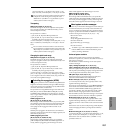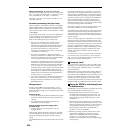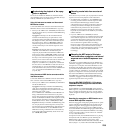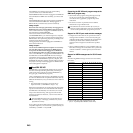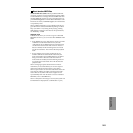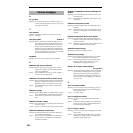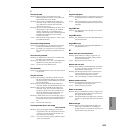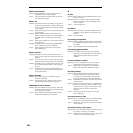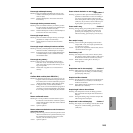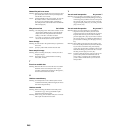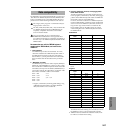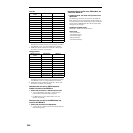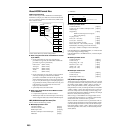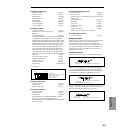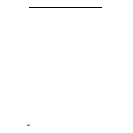
245
Appendices
Not enough multisample memory
Not enough relative parameter memory
Not enough sample memory
Not enough sample/multisample locations available
Not enough song memory
O
Oscillator Mode conflicts (check PROG P2.1)
P
Pattern conflicts with events
Pattern exists across destination to-end-of-measure or
source from-measure
Pattern exists in destination or source track
Open pattern ?
Pattern used in song Continue ?
R
Rear sample is empty
Root directory is full
S
Sample data used in other sample(s) Continue ?
Sample L and R are identical
Sample length is shorter than minimum
Sample used in other multisample(s) Continue ?
Meaning: There is insufficient multisample memory. (The
number of multisamples would exceed the maxi-
mum of 1,000.)
Action: Delete multisamples to increase the amount of
free memory.
Meaning: There is insufficient memory for relative parame-
ters. (The number of samples in the multisamples
would exceed the maximum of 4,000.)
Action: Delete multisamples or indices of multisamples to
increase the amount of free memory.
Meaning: There is insufficient sample memory (for sample
parameters or sample waveform data).
Action: Delete samples to increase the amount of free
memory.
Meaning: The data you attempted to load would exceed the
maximum number of multisamples or samples.
Action: In Sampling mode, execute “Delete Multisample”
or “Delete Sample” to free a sufficient number,
and reload the data.
Meaning: When executing the Sampling mode function
Time Slice “Save,” the total data for all song has
used up the entire sequence data memory, so sav-
ing is not possible.
Action: Delete other song data etc. to increase the free
memory.
Meaning: In Sampling mode when you executed “Conv. To
Program” with Use Destination Program Parame-
ters checked, the conversion destination program
“Mode (Oscillator Mode)” setting did not match.
Action: In Program mode, set the “Mode (Oscillator
Mode)” of the conversion destination program. If
converting a monaural multisample, select Single.
If converting a stereo multisample, select Double.
Meaning: It was not possible to execute the Bounce opera-
tion because one of the tracks contained a pattern,
and the same measure of the other track contained
events or a pattern.
Action: Open the pattern.
Meaning: When moving a measure, the edit operation could
not be executed because a pattern had been put in
the destination end measure or the source start
measure, and had not been opened.
Action: Open the pattern.
Meaning: A pattern has been placed in the track that you
specified as a destination or source for editing. If
you wish to open the pattern and execute (the
events of the pattern will be copied), press the[F8]
(“OK”) key. If you wish to execute without open-
ing the pattern, press the [F7] (“Cancel”) key.
Meaning: During editing, the specified pattern has been Put
to a track or is used by RPPR. To continue the
operation press the [F8] (“OK”) key. To cancel
without executing, press the [F7] (“Cancel”) key.
Meaning: When executing the Sampling mode function
Sample Edit “Link,” the sample specified as the
rear sample was empty.
Action: Specify a rear sample that contains data, and exe-
cute the function once again.
Meaning: You attempted to create a file or directory in the
root directory of the media, but this would exceed
the maximum number of root directory entries.
Action: Either delete an existing file or directory, or
exchange media.
Meaning: Other sample(s) use the same sample data as the
sample that you are editing. To continue editing,
press the [F8] (“OK”) key.
Meaning: The edit operation could not be executed because
the destination (save location) L and R sample
numbers are identical.
Action: Select different sample numbers for L and R of the
destination (save location).
Meaning: You attempted to execute an editing operation
that would make the sample data shorter than 8
samples.
Action: Change the editing range so that the sample data
will be longer than 8 samples.
Meaning: The sample you are editing is used by other multi-
samples. To continue editing, press the [F8]
(“OK”) key.



